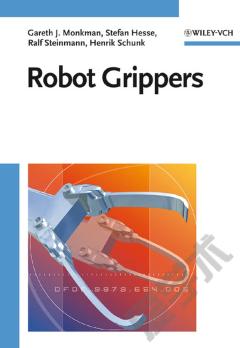Wearable Robots
Foreword. Preface. List of Contributors. 1 Introduction to wearable robotics ( J. L. Pons, R. Ceres and L. Calderon). 1.1 Wearable robots and exoskeletons. 1.2 The role of bioinspiration and biomechatronics in wearable robots. 1.3 Technologies involved in robotic exoskeletons. 1.4 A classification of wearable exoskeletons: application domains. 1.5 Scope of the book. References. 2 Basis for bioinspiration and biomimetism in wearable robots ( A. Forner-Cordero, J. L. Pons and M. Wisse). 2.1 Introduction. 2.2 General principles in biological design. 2.3 Development of biologically inspired designs. 2.4 Levels of biological inspiration in engineering design. 2.5 Case Study: limit-cycle biped walking robots to imitate human gait and to inspirethe design of wearable exoskeletons (M. Wisse). Acknowledgements. 2.6 Case Study: MANUS-HAND, mimicking neuromotor control of grasping (J. L. Pons, R. Ceres and L. Calderon). 2.7 Case Study: internal models, CPGs and reflexes to control bipedal walking robots and exoskeletons: the ESBiRRo project (A. Forner-Cordero). References. 3 Kinematics and dynamics of wearable robots (A. Forner-Cordero, J. L. Pons, E. A. Turowska and A. Schiele). 3.1 Introduction. 3.2 Robot mechanics: motion equations. 3.3 Human biomechanics. 3.4 Kinematic redundancy in exoskeleton systems. 3.5 Case Study: a biomimetic, kinematically compliant knee joint modelled by a four-bar linkage (J. M. Baydal-Bertomeu, D. Garrido and F. Moll). 3.6 Case Study: design of a forearm pronation-supination joint in an upper limb exoskeleton (J. M. Belda-Lois, R. Poveda, R. Barber'a and J. M. Baydal-Bertomeu). 3.7 Case Study: study of tremor characteristics based on a biomechanical model ofthe upper limb (E. Rocon and J. L. Pons). References. 4 Human-robot cognitive interaction ( L. Bueno, F. Brunetti, A. Frizera and J. L. Pons). 4.1 Introduction to human-robot interaction. 4.2 cHRI using bioelectrical monitoring of brain activity. 4.2.1 Physiology of brain activity. 4.2.2 Electroencephalography (EEG) models and parameters. 4.2.3 Brain-controlled interfaces: approaches and algorithms. 4.3 cHRI through bioelectrical monitoring of muscle activity (EMG). 4.3.1 Physiology of muscle activity. 4.3.2 Electromyography models and parameters. 4.3.3 Surface EMG signal feature extraction. 4.3.4 Classification of EMG activity. 4.3.5 Force and torque estimation. 4.4 cHRI through biomechanical monitoring. 4.4.1 Biomechanical models and parameters. 4.4.2 Biomechanically controlled interfaces: approaches and algorithms. 4.5 Case Study: lower limb exoskeleton control based on learned gait patterns (J. C. Moreno and J. L. Pons). 4.5.1 Gait patterns with knee joint impedance modulation. 4.5.2 Architecture. 4.5.3 Fuzzy inference system. 4.5.4 Simulation. 4.6 Case Study: identification and tracking of involuntary human motion based on biomechanical data (E. Rocon and J. L. Pons). 4.7 Case Study: cortical control of neuroprosthetic devices (J. M. Carmena). 4.8 Case Study: gesture and posture recognition using WSNs (E. Farella and L. Benini). 4.8.1 Platform description. 4.8.2 Implementation of concepts and algorithm. 4.8.3 Posture detection results. 4.8.4 Challenges: wireless sensor networks for motion tracking. 4.8.5 Summary and outlook. References. 5 Human-robot physical interaction ( E. Rocon, A. F. Ruiz, R. Raya, A. Schiele and J. L. Pons). 5.1 Introduction. 5.1.1 Physiological factors. 5.1.2 Aspects of wearable robot design. 5.2 Kinematic compatibility between human limbs and wearable robots. 5.2.1 Causes of kinematic incompatibility and their negative effects. 5.2.2 Overcoming kinematic incompatibility. 5.3 Application of load to humans. 5.4 Control of human-robot interaction. 5.5 Case Study: quantification of constraint displacements and interaction forces in nonergonomic pHR interfaces (A. Schiele). 5.6 Case Study: analysis of pressure distribution and tolerance areas for wearable robots (J. M. Belda-Lois, R. Poveda and M. J. Vivas). 5.7 Case Study: upper limb tremor suppression through impedance control (E. Rocon and J. L. Pons). 5.8 Case Study: stance stabilization during gait through impedance control (J. C. Moreno and J. L. Pons). References. 6 Wearable robot technologies ( J. C. Moreno, L. Bueno and J. L. Pons). 6.1 Introduction to wearable robot technologies. 6.2 Sensor technologies. 6.3 Actuator technologies. 6.4 Portable energy storage technologies. 6.5 Case Study: inertial sensor fusion for limb orientation (J. C. Moreno, L. Bueno and J. L. Pons). 6.6 Case Study: microclimate sensing in wearable devices (J. M. Baydal-Bertomeu, J. M. Belda-Lois, J. M. Prat and R. Barbera). 6.7 Case Study: biomimetic design of a controllable knee actuator (J. C. Moreno, L. Bueno and J. L. Pons). References. 7 Communication networks for wearable robots ( F. Brunetti and J. L. Pons). 7.1 Introduction. 7.2 Wearable robotic networks, from wired to wireless. 7.3 Wired wearable robotic networks. 7.4 Wireless wearable robotic networks. 7.5 Case Study: smart textiles to measure comfort and performance (J. Vanhala). 7.6 Case Study: ExoNET (F. Brunetti and J. L. Pons). 7.7 Case Study: NeuroLab, a multimodal networked exoskeleton for neuromotor and biomechanical research (A. F. Ruiz and J. L. Pons). 7.8 Case Study: communication technologies for the integration of robotic systems and sensor networks at home: helping elderly people (J. V. Marti, R. Marin, J. Fernandez, M. Nunez, O. Rajadell, L. Nomdedeu, J. Sales, P. Agusti, A. Fabregat and A. P. del Pobil). Acknowledgements. References. 8 Wearable upper limb robots ( E. Rocon, A. F. Ruiz and J. L. Pons). 8.1 Case Study: the wearable orthosis for tremor assessment and suppression (WOTAS) (E. Rocon and J. L. Pons). 8.2 Case Study: the CyberHand (L. Beccai, S. Micera, C. Cipriani, J. Carpaneto and M. C. Carrozza). 8.3 Case Study: the ergonomic EXARM exoskeleton (A. Schiele). 8.4 Case Study: the NEUROBOTICS exoskeleton (NEUROExos) (S. Roccella, E. Cattin, N. Vitiello, F. Vecchi and M. C. Carrozza). 8.5 Case Study: an upper limb powered exoskeleton (J. C. Perry and J. Rosen). 8.6 Case Study: soft exoskeleton for use in physiotherapy and training (N. G. Tsagarakis, D. G. Caldwell and S. Kousidou). References. 9 Wearable lower limb and full-body robots ( J. Moreno, E. Turowska and J. L. Pons). 9.1 Case Study: GAIT-ESBiRRo: lower limb exoskeletons for functional compensation of pathological gait (J. C. Moreno and J. L. Pons). 9.1.8 Next generation of lower limb exoskeletons: the ESBiRRo project. 9.2 Case Study: an ankle-foot orthosis powered by artificial pneumatic muscles (D. P. Ferris). 9.3 Case Study: intelligent and powered leg prosthesis (K. De Roy). 9.4 Case Study: the control method of the HAL (hybrid assistive limb) for a swinging motion (J. Moreno, E. Turouska and J. L. Pons). 9.5 Case Study: Kanagawa Institute of Technology power-assist suit (K. Yamamoto). 9.6 Case Study: EEG-based cHRI of a robotic wheelchair (T. F. Bastos-Filho, M. Sarcinelli-Filho, A. Ferreira, W. C. Celeste, R. L. Silva, V. R. Martins, D. C. Cavalieri, P. N. S. Filgueira and I. B. Arantes). Acknowledgements. References. 10 Summary, conclusions and outlook ( J. L. Pons, R. Ceres and L. Calderon). 10.1 Summary. 10.2 Conclusions and outlook. References. Index.
{{comment.content}}








 京公网安备 11010802027623号
京公网安备 11010802027623号